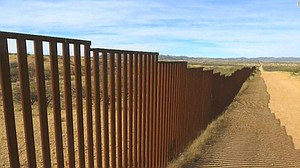7/27/2017

By Tal Kopan
CNN
WASHINGTON (CNN) -- Construction on prototypes for President Donald Trump's long-promised border wall has been delayed until winter at the earliest after bidders who were passed over filed protests about the decision, according to an update obtained by CNN.
The delay pushes back construction of the potential wall designs months beyond when the administration had hoped to break ground. The plan had originally been to build in June, and in recent weeks the Department of Homeland Security has insisted it was still on track to begin work on prototypes this summer.
But according to a memo sent out by the Customs and Border Protection legislative affairs office, obtained by CNN, two companies that were not selected to be finalists -- who then were asked to submit more detailed proposals -- filed a total of four protests of the process. While two of the protests, from WNIS, were dismissed, two from Penna Group are still under review and won't be decided until October, the update said.
That sets the earliest that prototype construction could begin for November, to be completed by early December. That's if no further protests are filed and if the original protests are dismissed, the update notes, and acknowledges that protests are a common part of government contracting.
CBP did not immediately respond to a request for comment.
The news comes as the House is set to vote Thursday night on a security funding package that would include money to build new border wall next fiscal year, though Democrats in the Senate have signaled they will oppose any such effort.
Since Congress has yet to appropriate any money for Trump's signature campaign pledge, the prototypes have been the only step the administration has been able to take in executing Trump's vision.
The requests for proposals, one for a 30-foot concrete barrier and one for anything else, were posted this spring, with the field being narrowed down and finalists asked for more detailed pitches.
For weeks DHS has been asked by reporters for a status update after it blew through its June target, but insisted the process was moving along on schedule.
The prototypes are set to be constructed along the border in San Diego, so that border agents can interact with them in a real-world border environment. The money for the process came from $20 million that Congress authorized DHS to pull from other places in the budget earlier this year.
While DHS has been unable to break ground on any new wall construction or the prototypes, the Army Corps of Engineers has been conducting testing in the areas that DHS has requested money to build in fiscal year 2018 -- 74 miles of border wall and levee wall mainly located in the Rio Grande Valley.
DHS says even if money were appropriated, procedures like environmental impact assessments would still need to be followed before construction could begin, but the testing will help DHS develop a plan for the areas more quickly.
The department has not said whether the prototypes will be required before any wall construction begins, but has characterized the process as a first step in determining what shape future border wall plans will take.
